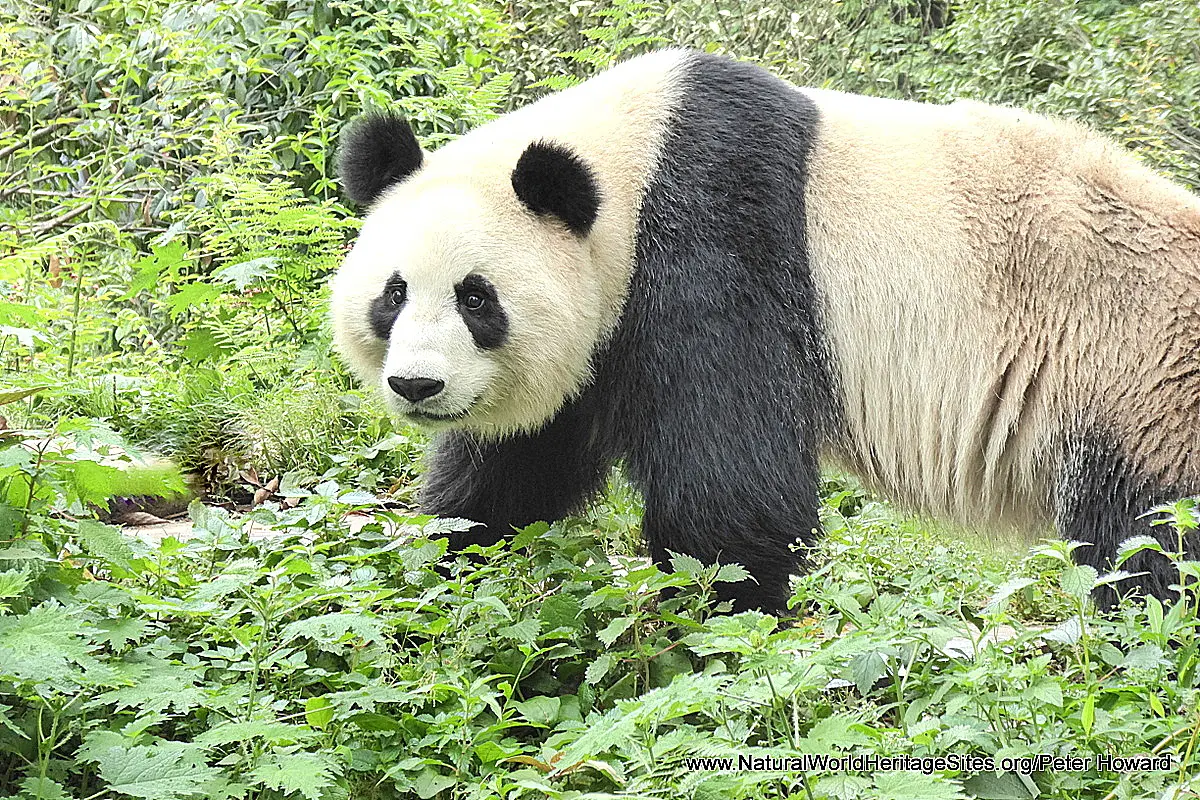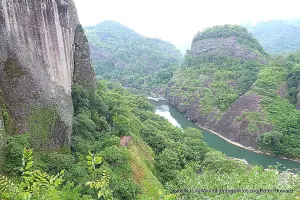EXPLORE CHINA’S SICHUAN GIANT PANDA SANCTUARIES with this slideshow, check the location map and get all the facts and information below.
For slideshow description see right or scroll down (mobile). Click to view slideshow
Location and Values: The Sichuan Giant Panda Sanctuaries of Wolong, Mount Siguniang and the Jiajin Mountains cover an extensive tract of mountainous terrain in southwest China’s Sichuan Province, where 30% of the world’s endangered giant pandas (about 500 individuals) survive. The sanctuaries include a vaste range of habitats over an altitudinal range of 5,670m, with glacier-capped peaks (the highest, Mount Siguniang reaches 6,250m), alpine meadows, a variety of mixed conifer and deciduous forests, with sub-tropical forests in the lower lying valleys. It is one of the world’s richest temperate areas for biodiversity, with 5-6,000 species of plants including highly diverse assemblages of plant groups such as roses, peonies, magnolias, bamboos and rhododendrons. There are 542 species of vertebrate animals, including other endangered species such as the red panda, snow leopard and Sichuan takin, and notable diversity in particular groups such as pheasants (with no fewer than 11 species recorded).
Conservation Status and Threats. According to IUCN’s most recent Conservation Outlook Assessment (December 2020) the conservation status of the Sichuan Giant Panda Sanctuaries is considered to be ‘good, with some concerns’. The exceptional values which are recognized by the site’s inscription on the World Heritage List are not seriously threatened, but a number of issues affecting conservation of the site are noteworthy, including:
- Climate change. The impacts of climate change are not yet fully understood but may already be responsible for a broad range of changes, increasing the vulnerability of species and habitats to irreversible change. The warming climate is resulting in the expansion of forested habitats to higher elevations in the mountains, while reducing the area of alpine meadows that occupy these cooler zones. Alterations in habitat composition as a result of climate change may benefit some species, including giant pandas, while others are adversely affected.
- Human settlement and associated use of natural resources. There are small settlements scattered throughout the Sichuan Giant Panda Sanctuaries, particularly along transport corridors. These are associated with local impacts on natural resources, including small-scale agriculture, grazing of domestic livestock, persecution of carnivores (including endangered species such as snow leopard and clouded leopard) and harvesting of natural products for craft work, medicines and firewood.
- Disturbance associated with roads. Several roads traverse the Sichuan Giant Panda Sanctuaries, resulting in a certain amount of disturbance to habitats and movement of animals. Some important sections of these roads have been routed through long tunnels, thereby protecting overhead habitats and maintaining viable wildlife corridors.
- Dams and hydropower infrastructure. There is a major dam within the Sichuan Giant Panda Sanctuaries at Qiaoqi and smaller dams in Wolong associated with hydropower generation. Since 2017 the government has gradually shut down small hydropower stations in the region, with more than 80% of them now closed. Licenses for the remaining stations will not be renewed and no new hydropower stations will be allowed within the Sichuan Giant Panda Sanctuaries.
- Management re-organisation. The Sichuan Giant Panda Sanctuaries include seven nature reserves and nine scenic parks which are currently being brought together as a single management unit (the Giant Panda National Park) under the authority of the new Sichuan Forestry and Grassland Bureau, 2019. This should help ensure a more consistent integrated approach to management in the future.
Links:
Google earth
Official UNESCO Site Details
IUCN Conservation Outlook
UNEP-WCMC Site Description
Birdlife IBA
Slideshow description
The slideshow is intended to ‘tell the story’ of the Sichuan Giant Panda Sanctuaries, through a portfolio of photos from a visit by Peter Howard in June 2017. The slideshow begins with some introductory photos of captive pandas at the Dujiangyan Panda Base, which is one of four such facilities which are working towards developing an effective captive breeding programme for this highly endangered animal, for eventual reintroduction to the wild. Here, pandas are kept in relatively large enclosures, before being transferred to semi-wild (larger) enclosures with a view to possible future release into the wild. Captive breeding is seen as a critical element in the overall conservation strategy for giant pandas, alongside protection of natural habitat where wild populations are maintained ‘in situ’. The Dujiangyan Panda Base is located in a valley of natural panda habitat at the edge of the world heritage area. From the panda base the slideshow features a few further photos of typical animals of the region, including some of the numerous species of pheasant, as well as high altitude ungulates such as blue sheep, Sichuan takin and tufted deer (as exhibited in the Chengdu zoo). It is not easy to view any of these animals in the wild as there is very limited access to their natural habitat and the animals are shy and retiring. The next series of photos in the slideshow shows the range of habitats and scenery within the world heritage site, following one of the few roads that traverses the site. From Dujiangyan the road follows a steep-sided forested valley through the Wolong Nature Reserve and ‘Wolong village enclave’, where there is a worthwhile ‘Giant Panda and Earthquake Museum’, with informative exhibits on the natural history and biodiversity of the area as well as the devastating impact of a major recent earthquake (which resulted in the closure of the Wolong Panda Base and Hetaoping Reintroduction Training Base, which were previously key elements of the giant panda ex-situ captive breeding and re-introduction conservation strategy). The slideshow continues with further photos of the higher reaches of the Wolong Nature Reserve, and then the high alpine meadows, temperate forests and snow-capped peaks within the adjoining Siguniang National Park. Tibetan monasteries, prayer flags and Buddhist monks add a splash of colour to the environment in the higher reaches of the sanctuaries. The slideshow features some of the diverse flowers found in the alpine meadows, where yaks also graze and Himalayan Griffon vultures soar overhead. At the end of the slideshow, another series of photos of giant pandas is included, featuring animals in semi-wild conditions at the captive breeding facility at Ya’An Bifengxia Panda Base.
Factfile
Website Category: Temperate & Boreal Forests
Area: 9245 km2
Inscribed: 2006
Criteria:
- Natural habitat for biodiversity (x);
- Significant number of rare, endemic and/or endangered species (x)





